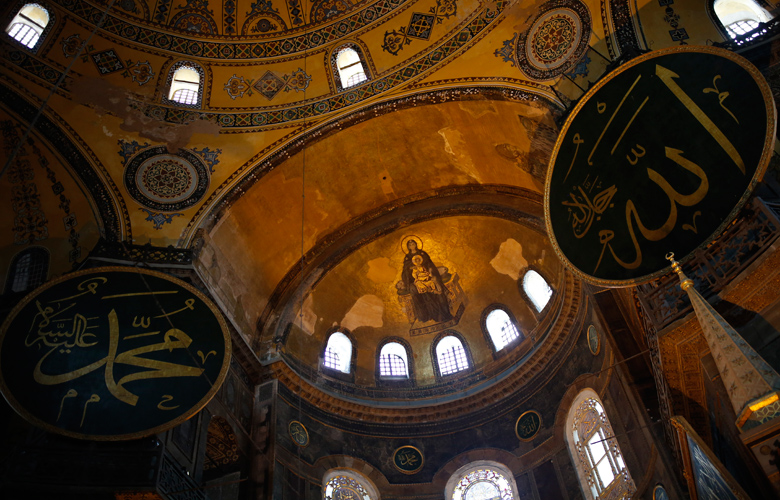It has now been officially confirmed by studies and measurements
The domes of her temple were built with materials from Rhodes Agia Sophia in Constantinople as has now been proven by studies done in previous years which confirmed the legends and traditions that existed on the island.
Indeed in past centuries its legends and traditions Rhodes mention that the domes of Hagia Sophia were built with light bricks manufactured in Rhodes, with a special technical fact that the inhabitants of the island were proud of.
These traditions have now been officially confirmed by studies and measurements.
Due to the size of the dome and the weight of the bricks used at the time, the construction was difficult in terms of statics, tightness and strength. The ceramic art of Rhodes was famous at that time.
Indicatively, in his study published several years ago, Athanasios Kossioris mentions the following about these traditions:
Antonis Vratsalis in “Niochoritika” writes: “The master craftsmen of the city, who were building the Great Monastery, when they reached the domes, had difficulty in fixing them and making them watertight, so that they would not crack.
That’s why they brought Rhodian ceramic bricks and soil, which were famous materials, and they matched the majestic domes, fixing them with well-smoothed khurasani, which was a mixture of lime with finely crushed, baked clay mixed with slippery murga of the oil mills.”
The honorary former High School Principal and historian I. Stefanidis in his book “Rhodes the nymph of the Sun”, writes:
“Among the building materials collected at that time for the construction of the pansept of this temple were the plinths from the clay soil of Rhodes, for the construction of the famous dome of Hagia Sophia, because these had the property of lightness, porosity and resistance to various weather and atmospheric changes of Byzantium. The bricks were thus thin and hollow, so that twelve of them corresponded to the weight of a common brick of other places. And they were made of a mixture of trifles, kisira powder, flour and other kinds, which did not acquire great hardness”.
The other teacher of Rhodes, the former High School Principal X. Papachristodoulou, in his book: “History of Rhodes” (p. 241) writes about pottery in Rhodes: “The clay bricks of Rhodes are famous for their solidity and lightness. They were white and weighed 5 Rhodians as much as 1 of other places, it was underlined in APE BEE.
That is why when Justinian was building Hagia Sophia, says the Byzantine chronicler G. Kodinos ordered the dome’s bricks from Rhodes (G. Kod. Ed. Weber, Bonn. 1843).
Justinian, he says, sent the Cubicular Troilus, the Prefect Theodore and the Quaistor Basilides to the island of Rhodes, to make there “vasals large, spongy and thin and white, the station of five vasals of a vesalus uterus is found”. In the book “The Island of Rhodes” by Edouard Biliotti and Abba Cotre, 1881 (Translation by M. Malliarakis and S. Karavokyrou) we read on page 209: “Byzantine authors mention, singing about Hagia Sophia, plinths made in Rhodes, by its great dome was built of this magnificent temple. The bricks were white and hollow, so that twelve of them corresponded to the weight of a common brick of other places.
And they were made of a mixture of broken ropes, buckwheat flour, flour and other kinds, which acquired great hardness”.
So the fact of the construction of the dome of Agia Sophia with Rhodian materials affected the local community. Thus, we read in the book of the retired teacher Rinoula Bourda-Kambouris “The Vati I Loved”, that there is a toponym in the community of the village of Vati, near the border with Gennadi, called Agia Sophia. The area is to the right of the road from Gennadi to Vati at the height before the Eurymacheia fountain. (Water is still flowing). So there they built a small Monastery-Church dedicated to Hagia Sophia.
Apparently the clay of the soil and the chronological placement of the church in about the 6th century, strengthen the opinion that the name Agia Sophia of the area and the temple was given to indicate that the materials for the construction of the dome of the famous church of Constantinople were taken from there.
Today there is only a part of the wall towards the sanctuary of the church and many fragments of ceramic vessels (known in the local dialect as “vastria”).
We also find a lot of information in the book by Kostas Skandalidis “The Gennadi of Rhodes”, where both the location and the legends are confirmed. It also includes the scientific study published in the Journal of the American Ceramic Society on the origin and technology of ceramics from Hagia Sophia in Istanbul. The study was by scholars Antonias Moropoulou, Ahmet Cakmak and Kyriaki Polykretis. Samples were taken from both Rhodes and the temple of Agia Sophia, and physicochemical analysis confirmed the origin of the materials from Rhodes. (Moropoulou Antonia, Cakmak Ahmet, Polikreti Kyriaki, “Provenance and Technology Investigation of Agia Sophia Briks, Istanbul, Turkey”, in Journal of the American Ceramic Society, February 2002, pp. 366-372).
To demonstrate the importance of Ag. Wisdom about Hellenism and how strongly it had particularly influenced the popular strata, can be seen from the exaggerations of legends and traditions. A writes. Vratsalis: “When the Hagia Sophia was being built, the stones were rolled down from the hill of the Acropolis of Rhodes (He means Monte Smith) and went to the City. When the news came that the Great Monastery was finished, they suddenly stopped and the eminasis where we see them today in Kato Petras, at the exit of the city towards Cretiki”.
The landslide of the rocks of the Acropolis of Rhodes was apparently caused by some natural phenomenon (earthquake, soil erosion from rainfall, etc.), but the legend shows the feeling of the island’s inhabitants to help the building of Hagia Sophia on the one hand On the other hand, it confirms the fact of the use of Rhodian materials for the sterilization of the dome.
“We managed through the materials to read the secrets of the Byzantine craftsmen”, said a few years ago to the newspaper TA NEA the professor of the National Technical University of Athens Antonia Moropoulou, who presented the results of a long-term research carried out by the universities of Princeton in the USA, of Bogazici of Turkey and from the NTUA in the publication he signs under the title “The Greek contribution to the maintenance of Agia Sophia”, which was issued by the Technical Chamber of Greece.
Raw materials from Rhodes and a special technique from the East were combined to create the optical bricks in the current, second, dome of Hagia Sophia, as the first one collapsed in an earthquake. To prove the legend that the dome’s bricks were made to order, the researchers compared the building materials of Hagia Sophia with contemporary buildings from Polis and Rhodes. The results showed that 95% of the raw materials come from Rhodes, they are enriched in clay and can produce compact and highly durable optical bricks. As for the technique of firing (baking the bricks) it has its roots in the East where this specific know-how was particularly developed.




